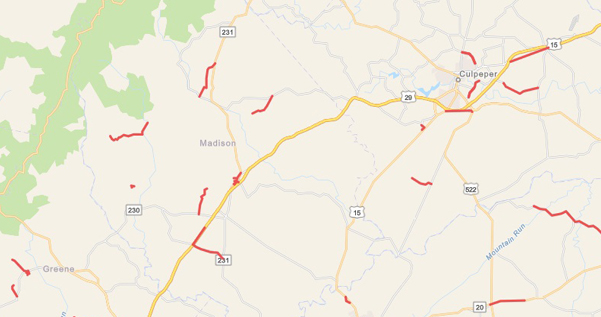Under Construction: 2023 Culpeper District Paving & Resurfacing
Cost and schedule ►
Traffic alerts ►

Route Information
VDOT has begun paving operations with resurfacing planned in the nine counties of the Culpeper District. VDOT has posted an interactive map that displays:
- paving locations
- status (schedule, in progress, completed or deferred until the following season)
- contact information
View map of roads to be resurfaced in 2023
Click on a colored road segment and a pop-up will appear with details about resurfacing, including treatment type, location and contact information.
Reminder: Contract crews make every effort to adhere to schedules, but schedule changes may be necessary due to weather, unforeseen issues with equipment, material availability or changes to other schedules. Crews will resume original resurfacing operations as soon as possible. Thank you for your understanding!
Pavement Treatment Types
Plant mix asphalt: This treatment is applied as a hot material in layers and compacted. Read more.
Microsurfacing, or latex-modified emulsion treatment, will be used to slow deterioration and fill in minor cracking. Motorists may notice an increase in noise as they travel across the skid-resistant surface, which is created by adding sand. With wear and over time, the noise will dissipate. Read more.
Surface treatment, also called tar-and-gravel or chip seal, will be applied to secondary routes and residential streets to extend pavement service life. This treatment involves the application of liquid asphalt and small stones embedded into the pavement. A final coating of sand prevents the liquid asphalt from being picked up by tires during the curing period, usually one to three weeks. Read more.
Multi-layer (or cape seal): Involves spraying a thin film of heated liquid asphalt on the road surface followed by a layer of fine gravel. The gravel is compacted so it adheres to the asphalt. It takes about two weeks for any loose gravel to work its way into the pavement. After the new road surface has cured, excess gravel is swept away and a slurry seal is applied. Residents can use the road soon after the gravel has been applied for the first layer of treatment. Once the slurry seal layer is in place, the road will need several hours to harden.
Slurry seal: This treatment, which is a mix of liquid asphalt and small stones spread over the road surface, is also designed to extend pavement life by waterproofing and sealing cracks. Read more.
FAQs
VDOT maintenance staff monitors roadway conditions throughout the year. Each summer, contracts are created for the next year’s paving work. The paving industry bids on these contracts and they are awarded in the late fall and winter, with the work performed during the next paving season, April to November, as weather cooperates.
VDOT works diligently to maintain a state of good repair on Virginia’s roadways. Some relatively inexpensive paving applications can be used to maintain pavement condition, particularly by sealing out moisture, which causes potholes and other damage. With this approach, VDOT stretches limited funding while maintaining the service life for thousands of miles of pavement.
When can I expect work to begin on my street?
Contractors will distribute a general notice to each neighborhood resident approximately 30 days in advance. An exact start date is typically known about 10 days before work begins. Giving contractors flexibility to schedule their work based on personnel and equipment availability allows Virginia to secure paving work at a competitive price.
In subdivisions, "no parking" signs with precise date information will be posted a minimum of 3 business days in advance of work starting.
What will take place? What will residents see, hear and observe?
Residents can expect to see and hear work vehicles in their neighborhood during the paving operation. Use caution when driving or walking near the work area.
Paving generally takes 1 to 2 weeks to complete, plus additional time for repainting pavement markings. Some treatments have a curing period, during which your ride may be rougher and/or dustier than usual, but conditions typically improve within several weeks.
What are the work hours for paving?
Work hours are generally limited to weekdays between dawn and dusk.
How are contractors overseen?
VDOT inspectors are on-site to ensure work is carried out according to contract requirements and state specifications. Deficient work will be corrected as soon as feasible.
My road is not on the list of roads to be treated this year. How can I request that it receive treatment next year?
Contact VDOT’s 24-hour Customer Service Center at 1-800-FOR-ROAD (367-7623) to let us know about your maintenance concerns.
Safety
Motorists are urged to drive attentively and reduce speed when approaching paving crews at work. Put down your phone, obey traffic controls and be prepared to brake for slow-moving equipment entering or exiting the highway.
Be patient as we work to improve your future travels!
Benefits
Resurfacing operations improve the condition and the longevity of road surfaces.
Resources
VDOT Customer Service Center
1-800-367-7623
Other relevant links:
Lat/Long: Not Available
Locality:
Albemarle
,
Culpeper
,
Fauquier
,
Fluvanna
,
Greene
,
Louisa
,
Madison
,
Orange
,
and
Rappahannock



